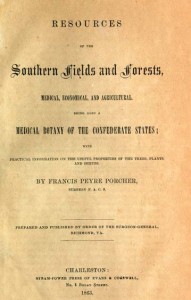Though produce and meat constituted the bulk of regularly preserved and stored food, other plants and herbs were also important to Native Americans. Many modern consumers know the benefits of teas made from chamomile, mint, and and sage, for example, and newcomers to the continent brought medicinal plants with them both on purpose or by accident when seeds hopped rides with cargo. Peoples throughout the world have relied on the plant world for their medicines, and still do where big pharmaceutical companies have not made inroads or aren’t trusted. Patent medicines–typically vegetable extracts with plentiful amounts of alcohol, opium, or cocaine–were popular in the U.S. as early as the 1700s. However, most native peoples and settlers favored plant preparations which had some validated success.
During the Civil War, the Confederate Army relied on plant-based remedies to such an extent that it commissioned a study of herbal medicines, Resources of the Southern Fields and Forests by Francis Porcher, to aid their treatment of soldiers. Doctors used onion and garlic from the allium family for their antibacterial effectiveness with injuries. The reasons behind many herbal remedies weren’t clearly understood at the time, but doctors realized that these plants facilitated recovery for soldiers with wounds and skin infections. Yarrow was an effective blood-stopping agent. Soldiers themselves used American pennyroyal as an insect repellent by rubbing the fresh plant over their skin. Unfortunately, alcohol and opiates continued to hold a powerful position with military doctors, as did harmful mercury-based products like calomel.
______________________________________________________________________________________


